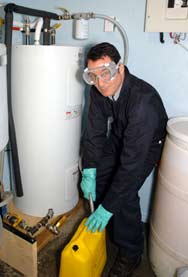
Kemp: crazy car, crazy guy
The Auto industry could perfectly well build a zero-carbon car tomorrow, at a lower cost, and a lower running cost, than conventional vehicles. But they don’t because too many entrenched interests are at stake. Now author Bill Kemp has come up with an audacious plan to shame them all, and it looks set to succeed.
Kemp has built his own low-carbon car for around $35,000, top speed, 140 kph, and will release the plans next month for anyone else to do the same. “Zero-carbon Car: Building the Car the Auto Industry Can’t Get Right” recounts his experience in building the car, and offers detailed instructions on how to replicate his achievement.
You can pre order it here.
Along with no carbon emissions, there’s also no noise pollution, says Kemp of the souped up Mazda — “it’s so quiet, you can’t even tell it’s turned on. But hit the gas pedal and off you go, with the wind in your hair.”
Unlike other hybrids, this is a truly zero-carbon car, not only while driving but also while refuelling. When the big yellow cord is plugged into the outlet near the trunk to recharge the eight batteries (which take six hours to charge fully, but can be driven on a partial charge) under the hood, the electricity comes from photovoltaic solar panels on Kemp’s roof and a wind turbine next to his off-grid home near Toronto. He also purchased shares from Bullfrog Power — a green-electricity company founded in 2005 with outlets in Alberta and Ontario — so he can plug the car in elsewhere and know the electricity comes from renewable sources.
The batteries are depleted after about 60 kilometres. That’s when the diesel engine — modified to take 100 per cent biodiesel and mounted in the trunk — kicks in to recharge the batteries as you continue driving. He said that 80 per cent of all driving adds up to less than 60 kilometres per day.
“For most people, most of the time, a vehicle that could go 60 kilometres without using carbon-based fuels would be sufficient.”
Kemp believes that society cannot afford to keep building and maintaining roads and bridges that only expand the number of drivers. He envisions a future where carbon-free electric trains, rather than cars and trucks, move goods and people between cities, and businesspeople use video teleconferencing rather than jumping on planes.
He proposes a substantial carbon tax that would put gasoline prices at $3.50 a litre.
“People will curtail their driving habits,” he said, and there will be eco-friendly vehicles, more carpooling, and mass transportation that people actually use.
Until society gets to that point, there’s a need for transition vehicles like the Zero Carbon Car, he said. His car uses biodiesel to assist the electric power that drives the wheels, compared with hybrids like the Toyota Prius and Honda Civic, which use electricity to assist the primary gas power.
“It’s a very simple technology. There’s nothing that needs to be invented. The technology’s available today.”
Kemp and a group of friends bought the 2001 Mazda Miata and gutted it. Under the hood, they installed an electric motor, eight batteries and various controllers. In the trunk are an alternator and a $15,000 diesel engine from Germany.
The glove compartment houses a control panel and voltage and amp meters. The dashboard stereo was replaced with a touchscreen computer to monitor and control the various systems, including the music system and automatic garage door opener. Total cost: about $35,000.
There’s nothing exactly like it on the market today because there’s no incentive for it, he said.
“No need. Just go buy a Hummer. Fossil fuels are cheap.”
General Motors’ Volt is similar to Kemp’s car, but it’s still a concept that’s not due on the market until 2010 at the earliest. Zenn Motor Company’s all-electric Zenn car has a top speed of 40 kilometres per hour.
Tesla Motors’ has a high-speed all-electric $98,000 US Tesla, and Commuter Cars has its ultra-narrow Tango but, as with other all-electric cars, once you’ve driven the maximum range, you have to wait for batteries to recharge.
“The plug-in hybrid solves all those problems,” Kemp said.
Even though the Miata body is heavy, he estimates the car costs five cents per kilometre to operate, compared with a more conventional car at about 9.2 cents. Top speed is 140 kilometres per hour and it’s fully licensed and insured.
Kemp’s book will show people how to build their own, without waiting for the car industry or government to lead the way.
“We can use this technology immediately and embarrass governments and the automobile industry into producing these cars because if homeowners and university and college students can do it, there’s no reason why we shouldn’t,” he said.
Zero-carbon Car: Building the Car the Auto Industry Cant Get Rightwill be published by Aztext Press.